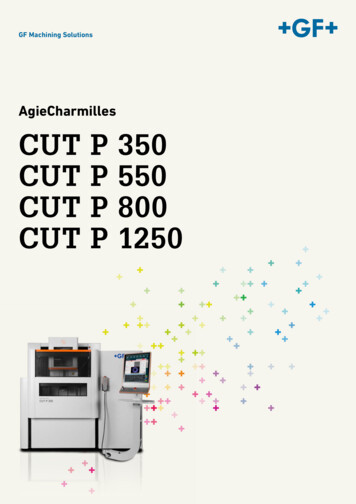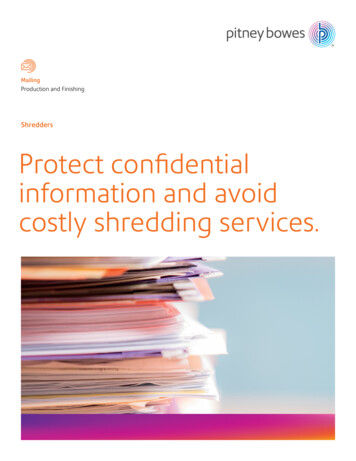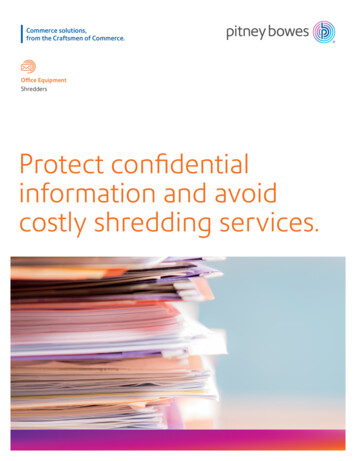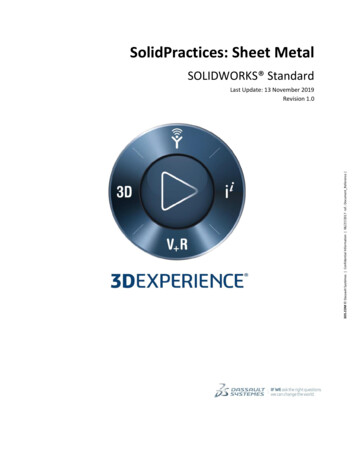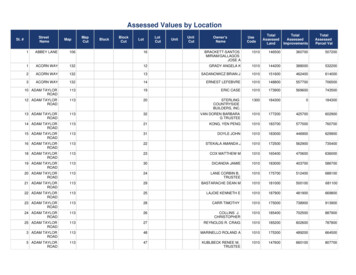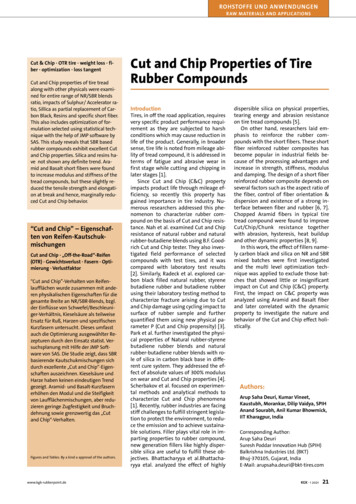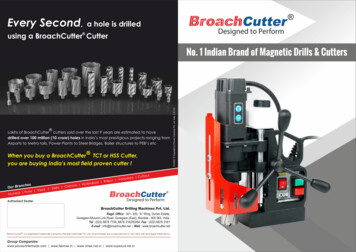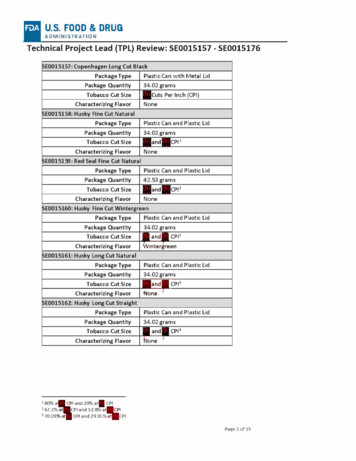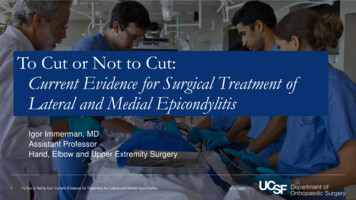
Transcription
To Cut or Not to Cut:Current Evidence for Surgical Treatment ofLateral and Medial EpicondylitisIgor Immerman, MDAssistant ProfessorHand, Elbow and Upper Extremity Surgery1To Cut or Not to Cut: Current Evidence for Treatment for Lateral and Medial EpicondylitisHTA 2020
Disclosures None relevant to the material presented ROM3 Skeletal Dynamics BIT Arthrex / Evolution Surgical2To Cut or Not to Cut: Current Evidence for Treatment for Lateral and Medial EpicondylitisHTA 2020
Talk Outline Introduction Diagnosis Surgical management Describe different surgical options Literature on surgical outcomes‒ Comparing different surgical options‒ Comparing surgical to non-surgical treatment My practice3To Cut or Not to Cut: Current Evidence for Treatment for Lateral and Medial EpicondylitisHTA 2020
4To Cut or Not to Cut: Current Evidence for Treatment for Lateral and Medial EpicondylitisHTA 2020
Disclosures I’m a surgeon, talking about tennis elbow surgery I have seen HUNDREDS if not more patients with tennis elbow I have only done 3 pure tennis elbow procedures Why? My goal for this talk: take you through the evidence behind my practice5To Cut or Not to Cut: Current Evidence for Treatment for Lateral and Medial EpicondylitisHTA 2020
6To Cut or Not to Cut: Current Evidence for Treatment for Lateral and Medial EpicondylitisHTA 2020
Anatomy7To Cut or Not to Cut: Current Evidence for Treatment for Lateral and Medial TA 2020
Tendinitis? Tendinosis? Tennis Elbow Lateral Epicondylitis Golfer’s Elbow Medial Epicondylitis Tendinitis: Implies inflammation Everything about this is a misnomer8To Cut or Not to Cut: Current Evidence for Treatment for Lateral and Medial EpicondylitisHTA 2020
EpidemiologyDasilva MF, Raizman NM. Lateral and Medial Elbow Tendinopathy and Olecranon Bursitis. 2nded. Chicago, IL: American Society for Surgery of the Hand; 2019. Golfers – up to 33% will develop this over their careers Tennis players – up to 50%9To Cut or Not to Cut: Current Evidence for Treatment for Lateral and Medial EpicondylitisHTA 2020
10To Cut or Not to Cut: Current Evidence for Treatment for Lateral and Medial EpicondylitisHTA 2020
EpidemiologyDasilva MF, Raizman NM. Lateral and Medial Elbow Tendinopathy and Olecranon Bursitis. 2nded. Chicago, IL: American Society for Surgery of the Hand; 2019. BUT, these athletes are just a small percentage of affected patients 2-3% of general population; 40s and 50s; men women; Lateral is 7-10 times more common than medial Commonly work-related (12% in repetitive worker) Risk factors: smoking, obesity, strenuous physical labor, repetitive use,precision manual work11To Cut or Not to Cut: Current Evidence for Treatment for Lateral and Medial EpicondylitisHTA 2020
12To Cut or Not to Cut: Current Evidence for Treatment for Lateral and Medial EpicondylitisHTA 2020
Dasilva MF, Raizman NM. Lateral and Medial Elbow Tendinopathy and Olecranon Bursitis. 2nded. Chicago, IL: American Society for Surgery of the Hand; 2019.Pathophysiology - Tendinopathy This is TENDINOPATHY Evidence shows: Lack of inflammatory cells Normal levels of inflammatory mediators Possibility of inflammatory component in early disease Chronic, attritional, degenerative process13To Cut or Not to Cut: Current Evidence for Treatment for Lateral and Medial EpicondylitisHTA 2020
Dasilva MF, Raizman NM. Lateral and Medial Elbow Tendinopathy and Olecranon Bursitis. 2nded. Chicago, IL: American Society for Surgery of the Hand; 2019.Pathophysiology - Tendinopathy Repetitive microtrauma mechanical overload microtears in the tendon Inability to heal quickly Hypovascular tissue around the epicondyle impaired healing Neurogenic causes (radial tunnel, cubital tunnel, or local neuroma)14To Cut or Not to Cut: Current Evidence for Treatment for Lateral and Medial EpicondylitisHTA 2020
Dasilva MF, Raizman NM. Lateral and Medial Elbow Tendinopathy and Olecranon Bursitis. 2nded. Chicago, IL: American Society for Surgery of the Hand; 2019.Pathophysiology - Tendinopathy Pathology: “angio-fibroblastic dysplasia” Degenerated tendon tissue with immature blood vessels, fibroblasts,disorganized extracellular matrix Disorganized tissue can predispose to further injury Molecules associated with pain (substance P, calcitonin gene-relatedpeptide)15To Cut or Not to Cut: Current Evidence for Treatment for Lateral and Medial EpicondylitisHTA 2020
MRI findings of tennis elbow are common Not directly related to pain 5.7-16% of patients WITHOUT symptoms have MRI findings of signal changesin ECRB Increases with age16To Cut or Not to Cut: Current Evidence for Treatment for Lateral and Medial EpicondylitisHTA 2020
Psycho-Social Factors Somewhat mixed evidence but if yousee these patients, it certainly seems tobe true Anxiety Depression Pain catastrophizing Distress Kinesophobia17To Cut or Not to Cut: Current Evidence for Treatment for Lateral and Medial EpicondylitisHTA 2020
18To Cut or Not to Cut: Current Evidence for Treatment for Lateral and Medial EpicondylitisHTA 2020
Natural HistoryDaSilva, Raizman: Ch 44: Lateral and Medial ElbowTendinopathy and Olecranon Bursitis, in ASSHTextbook of Hand and Upper Extremity Surgery, 2019 Multiple studies: 80-90% resolution over about 1 year Natural history really varies (MULTIPLE FACTORS)‒ Example: Physicians w/ LE showed they were less likely to use NSAIDs, misswork, or receive injections, and all but 2/72 resolved within 2 years19To Cut or Not to Cut: Current Evidence for Treatment for Lateral and Medial EpicondylitisHTA 2020
Diagnosis Standard physical exam Relevant to surgical decision-making: Pain in an uncommon location‒ Radial nerve involvement – RTS‒ Posterolateral / RC elbow joint Instability UN symptoms / weakness20To Cut or Not to Cut: Current Evidence for Treatment for Lateral and Medial EpicondylitisHTA 2020
Diagnosis Imaging Usually not indicated XR is often routinely done anyway Dynamic fluoroscopy to identify instability US / MRI will show pathology – usually not needed Can also identify additional pathology (joint / nerve) EMG if UN is involved21To Cut or Not to Cut: Current Evidence for Treatment for Lateral and Medial EpicondylitisHTA 2020
Treatment Options – Focus on Surgical Management22To Cut or Not to Cut: Current Evidence for Treatment for Lateral and Medial EpicondylitisHTA 2020
“Refractory” epicondylitis Nobody offers surgery right off the bat How long to wait? Patient perspective: 3 months of no improvement is too long Most surgical studies: 6 months of no improvement is indication for OR Thus, the evidence that will be presented is for patients who “failed”non-operative treatment for at least 6 months23To Cut or Not to Cut: Current Evidence for Treatment for Lateral and Medial EpicondylitisHTA 2020
ECRB Debridement – “Nirschl Procedure” Open debridement of the abnormal tissue in the ECRB origin is the classicsurgical technique 84% good-excellent results long-term 97% overall improved; 93% rate of return to sportImage from Green’s 6th edition24To Cut or Not to Cut: Current Evidence for Treatment for Lateral and Medial EpicondylitisHTA 2020
Debridement of ME Long-term results: 94%good/excellent Pain improvedfrom 9 to 225To Cut or Not to Cut: Current Evidence for Treatment for Lateral and Medial EpicondylitisHTA 2020
Debridement and repair (LE) 94% return to activity 95% reduction in pain26To Cut or Not to Cut: Current Evidence for Treatment for Lateral and Medial EpicondylitisHTA 2020
Debridement and repair (ME) The degenerated tendon is debrided Origin is repaired back to bone, often with the use of a suture anchor27To Cut or Not to Cut: Current Evidence for Treatment for Lateral and Medial EpicondylitisHTA 2020
Arthroscopic Treatment of LE Arthroscopic treatment: ability to identify/treat intra-articular pathology Debridement of ECRB28To Cut or Not to Cut: Current Evidence for Treatment for Lateral and Medial EpicondylitisTenotomy of ECRBHTA 2020
Arthroscopic Treatment Debridement of ECRB or Tenotomy ofECRB 283 patients 78% overall excellent results 8-10% failure rate No significant differences exceptfaster RTW in debridement29To Cut or Not to Cut: Current Evidence for Treatment for Lateral and Medial EpicondylitisHTA 2020
Arthroscopic Treatment of ME Small series (7 patients) Origin of the common flexor/pronator tendon debrided proximal to UCL30To Cut or Not to Cut: Current Evidence for Treatment for Lateral and Medial EpicondylitisHTA 2020
Arthroscopic Treatment of ME31To Cut or Not to Cut: Current Evidence for Treatment for Lateral and Medial EpicondylitisHTA 2020
Denervation (LE) Transection of branches of thePosterior cutaneous nerve of theforearm 30 elbows in 26 patients, min 2yr f-up 80% good-excellent results VAS: 7.9 1.9 4 patients w/ failure (work comp orRTS)32To Cut or Not to Cut: Current Evidence for Treatment for Lateral and Medial EpicondylitisHTA 2020
Which surgery is better? Is one type of surgery better than others? POP-QUIZ! What was the rate of good/excellent results % in the various treatmentoptions? Which was the best? In ortho, we teach residents 85%/15% is always a good guess Seems to be the case here: what does the evidence tell us?33To Cut or Not to Cut: Current Evidence for Treatment for Lateral and Medial EpicondylitisHTA 2020
LE debridement: open vs scope 75 patients randomized 1 yr f-up No difference between thegroups Everyone got better “Notice the VAS and DASHscores at 12 mo – these are allsimilar across all studies”34To Cut or Not to Cut: Current Evidence for Treatment for Lateral and Medial EpicondylitisHTA 2020
LE debridement: open vs scope Meta-analysis included 6 studies “There was no significant difference with regards to failure rate, functionaloutcome score, and complication rate”35To Cut or Not to Cut: Current Evidence for Treatment for Lateral and Medial EpicondylitisHTA 2020
LE debridement: open vsscope vs percutaneous Systematic review included 6 studies Level 1 and 2 179 elbows total36To Cut or Not to Cut: Current Evidence for Treatment for Lateral and Medial EpicondylitisHTA 2020
Differences between surgical treatments? NONE Across multiple studies, there are no clinically important or significantdifferences in outcomes SOME LIMITATIONS IN THE DATA Some patients may benefit from one treatment over other‒ These differences will not be obvious in small studies‒ Challenge is to identify these patients37To Cut or Not to Cut: Current Evidence for Treatment for Lateral and Medial EpicondylitisHTA 2020
Surgery vs Non-operative Treatment38To Cut or Not to Cut: Current Evidence for Treatment for Lateral and Medial EpicondylitisHTA 2020
39To Cut or Not to Cut: Current Evidence for Treatment for Lateral and Medial EpicondylitisHTA 2020
Placebo Surgery40To Cut or Not to Cut: Current Evidence for Treatment for Lateral and Medial EpicondylitisHTA 2020
13 patients enrolled in each group Study stopped early due to prelim statistical analysis demonstrating a needfor 6500 patients per group to demonstrate a significant difference Surgery: Nirschl technique, debridement and drilling of the bone Placebo: Same incision, the skin was dissected down to the ECRB tendon tovisualize the abnormal tissue. This was NOT excised, and skin was closed. Follow-up 6mo and 2.5 years41To Cut or Not to Cut: Current Evidence for Treatment for Lateral and Medial EpicondylitisHTA 2020
No differences across any of the measures (pain, stiffness, function)42To Cut or Not to Cut: Current Evidence for Treatment for Lateral and Medial EpicondylitisHTA 2020
43To Cut or Not to Cut: Current Evidence for Treatment for Lateral and Medial EpicondylitisHTA 2020
Included 12 studies on various tendinopathy: Shoulder (7), LE (3), Patellar (1), Achilles (1)44To Cut or Not to Cut: Current Evidence for Treatment for Lateral and Medial EpicondylitisHTA 2020
Is there any effective treatment at all?45To Cut or Not to Cut: Current Evidence for Treatment for Lateral and Medial EpicondylitisHTA 2020
Non-op Tx vs Observation/Placebo 22 RCTs comparing various non-operative treatments to observation/placebo Various injections, NSAIDs, splints, braces, PT, shock wave, laser, UStherapy46To Cut or Not to Cut: Current Evidence for Treatment for Lateral and Medial EpicondylitisHTA 2020
47To Cut or Not to Cut: Current Evidence for Treatment for Lateral and Medial EpicondylitisHTA 2021
So is there ANY role for surgery? Possibly yes Are there any red flags?‒ Ulnar nerve neuritis / cubital tunnel syndrome Severe pain or “nerve pain” Symptoms of UN irritation Extension contracture of the elbow48To Cut or Not to Cut: Current Evidence for Treatment for Lateral and Medial EpicondylitisHTA 2020
My Practice Ulnar nerve neuritis / cubital tunnel syndrome 34yo F, 1.5 years of medial elbow pain, multiple MD opinions, therapy, severalsteroid injections, MRI w/ medial epicondylitis – presumed dx Can’t flex elbow beyond 90 degrees because of medial elbow pain NO numbness/tingling/weakness by report but 4/5 ADM strength on exam49To Cut or Not to Cut: Current Evidence for Treatment for Lateral and Medial EpicondylitisHTA 2020
My Practice Ulnar nerve neuritis / cubital tunnel syndrome 34yo F, 1.5 years of medial elbow pain, multiple MD opinions, therapy, severalsteroid injections, MRI w/ medial epicondylitis – presumed dx EMG/NCS normal – no UN abnormalities MRI – medial epicondylitis MR Neurogram: enlarged and edematous UN at the elbow50To Cut or Not to Cut: Current Evidence for Treatment for Lateral and Medial EpicondylitisHTA 2020
51To Cut or Not to Cut: Current Evidence for Treatment for Lateral and Medial EpicondylitisHTA 2020
My Practice Ulnar nerve neuritis / cubital tunnel syndrome Managed w/ UN decompression and submuscular transposition Allows for a concomitant debridement/repair, and lengthening offlexor/pronator origin52To Cut or Not to Cut: Current Evidence for Treatment for Lateral and Medial EpicondylitisHTA 2020
My Practice Careful and thorough evaluation Are there any red flags?‒ LUCL injury / instability‒ Clunking / giving way w/ weight bearing‒ Pain is more with elbow loading than with grip‒ More mechanical symptoms53To Cut or Not to Cut: Current Evidence for Treatment for Lateral and Medial EpicondylitisHTA 2020
My Practice Careful and thorough evaluation Are there any red flags?‒ LUCL injury / instability‒ 40yo M, over 1 year lateral elbow pain‒ Dx as epicondylitis, had steroid injection‒ While lifting weights, felt a pop, significantly worsened pain54To Cut or Not to Cut: Current Evidence for Treatment for Lateral and Medial EpicondylitisHTA 2020
My Practice Careful and thorough evaluation Are there any red flags?‒ LUCL injury / instability‒ MRI and fluoro exam in the office demonstrate ill-defined / avulsed LUCLand varus instability55To Cut or Not to Cut: Current Evidence for Treatment for Lateral and Medial EpicondylitisHTA 2020
56To Cut or Not to Cut: Current Evidence for Treatment for Lateral and Medial EpicondylitisHTA 2020
My Practice Careful and thorough evaluation Are there any red flags?‒ LUCL injury / instability‒ Managed with LUCL reconstruction with allograft, and concomitantdebridement/repair of the ECRB origin57To Cut or Not to Cut: Current Evidence for Treatment for Lateral and Medial EpicondylitisHTA 2020
My Practice Careful and thorough evaluation Are there any red flags or additional important pathology?‒ Intra-articular pathology: for example, plica, loose bodies‒ Mechanical symptoms (clicks, etc)‒ May be related to elbow position / forearm rotation‒ Tenderness more on the joint line and less on the LE‒ Can often see on imaging58To Cut or Not to Cut: Current Evidence for Treatment for Lateral and Medial EpicondylitisHTA 2020
My Practice Careful and thorough evaluation Are there any red flags or additional important pathology?‒ Intra-articular pathology: for example, plica in posterolateral RC joint59To Cut or Not to Cut: Current Evidence for Treatment for Lateral and Medial EpicondylitisHTA 2020
My Practice Careful and thorough evaluation Are there any red flags or additional important pathology?‒ Treat the additional pathology Reassurance The “tear” is not a “structurally important” tear Pain is NOT a sign of serious of ongoing damage OK to exercise / work through the pain Bracing, exercises, TIME – eventually it gets better60To Cut or Not to Cut: Current Evidence for Treatment for Lateral and Medial EpicondylitisHTA 2020
My Practice Careful and thorough evaluation Reassurance Bracing, exercises, TIME – eventually it gets better Rarely get advanced imaging – only generates more questions about the “tear” Rarely surgery61To Cut or Not to Cut: Current Evidence for Treatment for Lateral and Medial EpicondylitisHTA 2020
62To Cut or Not to Cut: Current Evidence for Treatment for Lateral and Medial EpicondylitisHTA 2020
My Practice Surgery Rarely done‒ Unless there is additional pathology (nerve, ligament, joint) Open debridement and repair of tendon back to origin with an anchor Why? Most comparative studies focus on the debridement alone – perhaps repairis better (no real evidence) Repair just makes sense to me63To Cut or Not to Cut: Current Evidence for Treatment for Lateral and Medial EpicondylitisHTA 2020
Natural HistoryDaSilva, Raizman: Ch 44: Lateral and Medial ElbowTendinopathy and Olecranon Bursitis, in ASSHTextbook of Hand and Upper Extremity Surgery, 2019 Multiple studies: 80-90% resolution over about 1 year Doesn’t seem to be any different from any treatment available BUT, what about the patients that don’t improve?64To Cut or Not to Cut: Current Evidence for Treatment for Lateral and Medial EpicondylitisHTA 2020
Future Directions Identify those patients that won’t improve on their own Design studies including ONLY those patients‒ Harder because there are very few of them around‒ Difficult to predict‒ Challenging to convince patients to suffer for over 1 year It is possible that benefits of surgery will emerge in this group I suspect it may be the debridement repair type of operation65To Cut or Not to Cut: Current Evidence for Treatment for Lateral and Medial EpicondylitisHTA 2020
Until then Frustrated doctors66To Cut or Not to Cut: Current Evidence for Treatment for Lateral and Medial EpicondylitisHTA 2020
Until then Frustrated patients67To Cut or Not to Cut: Current Evidence for Treatment for Lateral and Medial EpicondylitisHTA 2020
Until then Lots of treatment options thatmay be no better than placebo68To Cut or Not to Cut: Current Evidence for Treatment for Lateral and Medial EpicondylitisHTA 2020
11 To Cut or Not to Cut: Current Evidence for Treatment for Lateral and Medial Epicondylitis HTA 2020 Dasilva MF, Raizman NM. Lateral and Medial Elbow Tendinopathy and Olecranon Bursitis. 2nd ed. Chicago, IL: American Society for Surgery of the Hand; 2019.
